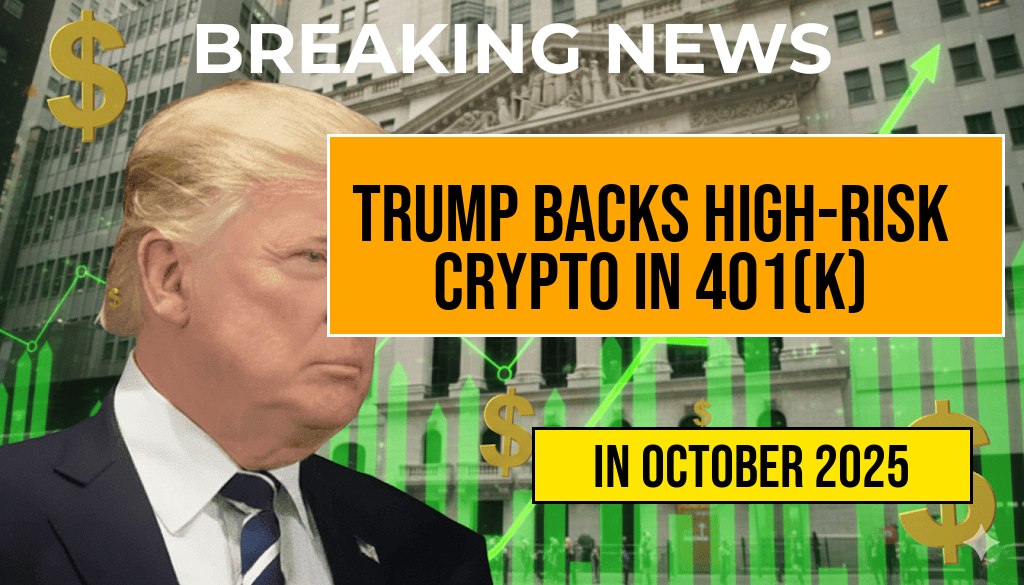Former President Donald Trump has recently voiced support for a proposed change to retirement investment regulations that could significantly alter the landscape of 401(k) plans. The new rule, currently under review by the Department of Labor, aims to permit high-risk, high-reward assets—particularly certain cryptocurrencies—to be included as investment options within retirement accounts. While proponents argue that this could unlock greater growth potential for savers, critics warn it introduces substantial risks that could jeopardize retirees’ financial security. Trump’s endorsement adds a high-profile political voice to the debate, which centers around balancing innovation in investment strategies with the need for prudent stewardship of Americans’ retirement savings.
Understanding the Proposed Regulation Change
Background and Scope
The Department of Labor (DOL) has been considering revisions to existing rules governing the types of assets that can be held within defined-contribution plans, such as 401(k)s. The proposed update aims to expand the permissible investment universe to include assets traditionally deemed high-risk, such as certain cryptocurrencies, commodities, and other alternative investments. Currently, federal guidelines favor more conservative options like stocks, bonds, and mutual funds, citing fiduciary concerns and the volatility associated with alternative assets.
The rule change, as outlined in recent regulatory proposals, seeks to clarify that plan sponsors can, with proper disclosures and due diligence, offer these alternative investments, giving participants greater control over their retirement portfolios. Supporters believe this could improve diversification and returns, especially amid prolonged low-interest rates and economic uncertainty.
Political and Industry Reactions
| Stakeholder | Position |
|---|---|
| Donald Trump | Supports allowing high-risk investments like cryptocurrencies in retirement plans, citing increased opportunities for growth. |
| Department of Labor | Advocates for expanding investment options while emphasizing fiduciary responsibilities and investor protections. |
| Financial industry groups | Mixed reactions; some endorse innovation, others warn against excessive risk exposure. |
| Consumer advocacy groups | Express concern over potential for increased losses and reduced retirement security. |
Potential Benefits and Risks
Advantages of the Proposed Changes
- Enhanced diversification: Including assets like cryptocurrencies could diversify retirement portfolios beyond traditional stocks and bonds.
- Growth opportunities: High-risk assets have historically offered substantial returns, which could boost overall retirement savings if managed prudently.
- Increased choice: Empowering participants to tailor investments to their risk tolerance may appeal to younger investors seeking higher growth potential.
Concerns and Challenges
- Volatility and losses: Cryptocurrencies are known for dramatic price swings, which could severely impact retirement balances during downturns.
- Fiduciary liability: Plan sponsors might face increased legal exposure if they include volatile assets without adequate safeguards.
- Investor protection: Critics argue that many retail investors lack the expertise to navigate high-risk investments within retirement accounts.
Regulatory Context and Future Outlook
Legal and Policy Considerations
The proposal aligns with broader efforts to modernize retirement savings options, but it also raises questions about the extent of fiduciary duties and transparency requirements. The DOL has emphasized that any inclusion of high-risk assets must be accompanied by comprehensive disclosures and risk warnings to protect investors. Meanwhile, legal challenges are anticipated from groups concerned about the potential for increased losses and mismanagement.
Implications for Retirement Savers
The ultimate impact of these regulatory changes will depend largely on how plan sponsors and participants respond. Financial advisors may need to develop new strategies to balance risk and reward, while regulators are likely to monitor the implementation closely. As the debate continues, retirement advocates and industry insiders await further guidance and clarity from the Department of Labor.
Additional Resources
- Wikipedia: 401(k) Retirement Savings Plan
- Forbes: How Cryptocurrency Could Transform Retirement Savings
- U.S. Department of Labor: Regulations and Guidance
Frequently Asked Questions
What is the new 401(k) rule proposed by Donald Trump regarding cryptocurrency investments?
The new 401(k) rule proposed by Donald Trump aims to allow high-risk cryptocurrency investments within retirement plans. This change would enable investors to include digital assets like Bitcoin and other cryptocurrencies in their 401(k) accounts.
Why does Donald Trump support allowing cryptocurrencies in retirement plans?
Donald Trump advocates for this change because he believes that cryptocurrencies offer investment diversity and could potentially provide higher returns. He argues that allowing high-risk investments like cryptocurrencies in retirement accounts can benefit investors seeking greater financial growth.
What are the potential risks associated with including cryptocurrencies in retirement plans?
Including cryptocurrencies in retirement plans involves significant risks, such as high volatility, lack of regulation, and potential for losses. Critics warn that these high-risk assets may jeopardize retirement savings, especially for retirees with a low risk tolerance.
How might this new rule impact retirement investors and the financial industry?
If implemented, the rule could significantly expand investment options for retirement investors, enabling them to diversify into cryptocurrencies. It may also lead to increased adoption of digital assets within the financial industry and prompt regulatory discussions around cryptocurrency investments.
What should investors consider before including cryptocurrencies in their retirement plans?
Investors should carefully evaluate the risks and volatility associated with cryptocurrencies. It’s important to consider their own risk tolerance, diversify their investment portfolio, and stay informed about regulatory changes before adding digital assets to their retirement savings.

Leave a Reply